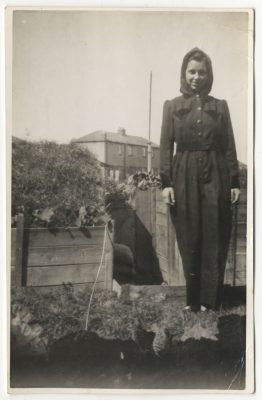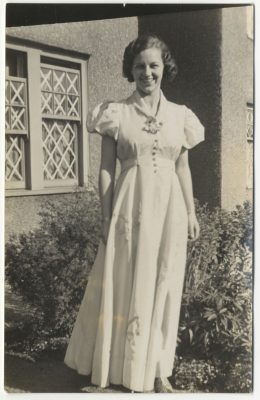Photographs of Miss Cozens in Blyth, about 1939
Reference: NRO 12073/15, 17
Suggested age groups: KS1, KS2, KS3, KS4, Lifelong Learners
Subject areas: WW2, Air Raids, Bombing of Blyth, Wartime Fashion
CONTEXT
In the first of these photographs Miss Cozens is standing in front of the family air raid shelter. The Cozens family lived at 50 First Avenue in Blyth and had an Anderson Shelter in the back garden. Like many families, they supplemented their rations by growing vegetables around their shelter. Miss Cozens is wearing a “siren suit”, there were designed to be easy to put on, in the case of an air raid during the night.
In the second photograph some of the family’s air raid preparations can clearly be seen. They taped the windows so that they would not shatter and cause injuries if they broke in a bomb blast.
ACTIVITIES
ACTIVITY 1
Background
In the first of these photographs Miss Cozens is standing in front of the family air raid shelter. The Cozens family lived at 50 First Avenue in Blyth and had an Anderson Shelter in the back garden. Like many families, they supplemented their rations by growing vegetables around their shelter.
In the second photograph some of the family’s air raid preparations can clearly be seen. They taped the windows so that they would not shatter and cause injuries if they broke in a bomb blast.
SEE
See: Where did the Cozens’ live?
See: What types of air raid precautions can you see in the photographs?
See: What type of air raid shelter did the Cozens’ have?
See: What did the Cozens’ grow around their air raid shelter?
THINK
Think: What impression do you have about the Cozens’ family based on what you can see in the photographs?
Think: How effective do you think the Cozens’ air raid precautions are?
Think: What is the difference between an Anderson Shelter and other types of air raid shelter?
Think: Why did families grow vegetables around their air raid shelters?
DO
Do: Use Google Maps to look up 50 First Avenue in Blyth. How much do you think the street will have changed since the photographs of Miss Cozens were taken?
Do: Use the data from the War, State and Society Bombing Britain database and the data from the North East Diary 1939-1945 website index for Blyth to create a timeline showing how often Blyth was bombed.
Do: Use the data from the War, State and Society Bombing Britain database and the data from the North East Diary 1939-1945 website index for Blyth to create a map showing where in Blyth was bombed.
Do: Use the data from the War, State and Society Bombing Britain database and the data from the North East Diary 1939-1945 website index for Blyth to find whether the Cozens’ street was ever bombed.
Do: Create a diagram annotating the features of an Anderson Shelter.
Do: Create a poster showing the different types of air raid shelters used during WW1 and annotate their different features.
Do: Use the information from your poster to come up with a list of pros and cons for the features of each different type of air raid shelter.
Do: In groups, debate the most effective type of air raid shelter during WW2.
Do: Use your pros and cons list of air raid shelter features to design a new and improved air raid shelter.
Do: Create a model of your air raid shelter design.
Do: Present your new air raid shelter design to the group as a Dragon’s Den style pitch.
Resources
http://www.warstateandsociety.com/Bombing-Britain
https://ne-diary.genuki.uk/PindexA.html#B
https://www.iwm.org.uk/history/what-to-do-during-an-air-raid
https://www.thehistorypress.co.uk/articles/shelter-at-home-in-the-second-world-war/
https://www.bbc.co.uk/history/ww2peopleswar/stories/29/a1125929.shtml
ACTIVITY 2
Background
Miss Cozens is wearing a “siren suit”, there were designed to be easy to put on, in the case of an air raid during the night.
SEE
See: What is Miss Cozens wearing in the first photograph?
See: What was the purpose of a siren suit?
THINK
Think: Who wore siren suits?
Think: When were siren suits worn?
Think: Why were siren suits needed?
Think: Who popularised the siren suit in Britain during the war?
Think: What was the design of the siren suit inspired by?
Think: Which clothing designs were inspired by the siren suit?
DO
Do: Create a timeline showing the clothing designs that inspired the creation of the siren suit, and the clothing designs that were inspired by the siren suit.
Do: Create a design mood board showing concepts behind the siren suit and how it has evolved over time.
Do: Develop a series of designs for a set of siren suits. You could come up with a concept inspired by your mood board about which variation of the siren suit you want to develop, for which audience and for which purpose. Annotate your designs.
Do: Create your chosen siren suit design.
Resources
https://www.iwm.org.uk/collections/item/object/30097186
https://eng410wwiilit.commons.gc.cuny.edu/2017/12/06/the-siren-suit/
https://turnbullandasser.co.uk/blogs/off-the-cuff/all-for-onesie-the-siren-suit
https://www.bbc.co.uk/history/ww2peopleswar/stories/39/a4522439.shtml
https://therake.com/stories/style/the-overall-effect-and-call-of-the-siren-suit/
https://thevintagetraveler.wordpress.com/2018/11/14/wwii-english-siren-suit/
OTHER ONLINE RESOURCES
BBC Peoples War website, page with memories of Blyth: https://www.bbc.co.uk/history/ww2peopleswar/stories/00/a6825800.shtml
Port of Blyth website, page about the history of the port: http://portofblyth.co.uk/history/
Air Raids
Imperial War Museum website, page about air raid preparation: https://www.iwm.org.uk/history/how-britain-prepared-for-air-raids-in-the-second-world-war
Imperial War Museum, page about what to do in an air raid: https://www.iwm.org.uk/history/what-to-do-during-an-air-raid
Imperial War Museum website, page with example of a “siren suit”: https://www.iwm.org.uk/collections/item/object/30097186
War, State and Society website, page with Bombing Britain database: http://www.warstateandsociety.com/Bombing-Britain
Air Raid Shelters
The Guardian newspaper website, page about Anderson Shelters today (includes photos of them): https://www.theguardian.com/world/2018/aug/21/how-britains-abandoned-anderson-shelters-are-being-brought-back-to-life
Anderson Shelters website (lots of information and some personal stories): https://www.andersonshelters.org.uk/
Spartacus Educational website, page about Anderson Shelters (includes primary sources): https://spartacus-educational.com/2WWandersonshelter.htm
RAF Museum website, page about different types of air raid shelters: https://www.rafmuseum.org.uk/research/online-exhibitions/history-of-the-battle-of-britain/air-raid-shelter-protection.aspx



